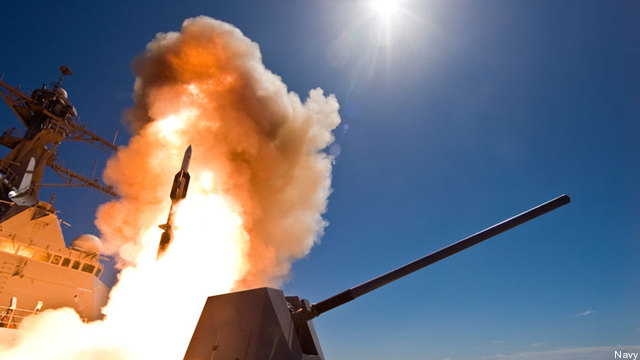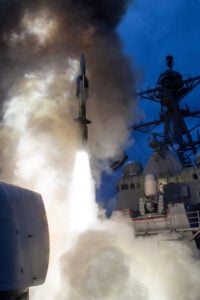SM-6 Can Now Kill Both Cruise AND Ballistic Missiles
Posted on

From the Persian Gulf to the South China Sea, the US military is getting more and more worried about the threat from various missiles. But all incoming missiles are not the same, which makes missile defense much harder. That’s the problem Raytheon’s SM-6 interceptor tackled in a recent test that has important tactical implications.
If you command a warship or a land base, your missile nightmares come in two flavors: ballistic and cruise. Ballistic missiles launch straight up and soar to the upper atmosphere — into outer space, for the longest-ranged weapons — before falling on their target like a hammer from heaven. Once their rocket boosters fall away, ballistic missiles follow a predictable trajectory like a cannonball (a ballistic trajectory, hence the name), but they descend so fast they’re very hard to hit.
Cruise missiles, by contrast, fly low over land and sea like an unmanned jet airplane — which they essentially are. Cruise missiles are much slower than ballistic missiles, but they can maneuver throughout their flight (again, like a plane) and they can use mountains or the horizon to mask their approach from radar, making them a different kind of hard target.
Because the two kinds of missiles are so different, defending against them has historically required different interceptors (essentially, anti-missile missiles). On July 28th, that changed.
In a series of tests announced yesterday, the Aegis destroyer USS John Paul Jones fired three of the latest variants of Raytheon’s Standard Missile, the SM-6 Dual I. The SM-6 is an agile, long-range weapon that uses the same seeker as the AMRAAM air-to-air missile to engage enemy cruise missiles and aircraft. But the Dual I upgrade adds a new, more powerful processor that runs more sophisticated targeting software. That software lets the SM-6 identify, track, and kill something descending from the upper atmosphere at extreme speed — specifically, a ballistic missile warhead.

The USS John Paul Jones test-fires an SM-6 in June
So on July 28th, the Missile Defense Agency launched “a short-range ballistic missile (SRBM) target” over the Pacific. The John Paul Jones launched an SM-6 Dual I and destroyed the target. Then, in two subsequent tests on July 31st and August 1st, SM-6 Dual Is also shot down two different kinds of cruise missile.
“It’s the only missile now out there that has what we call dual-mission capability,” hence the name, Raytheon program manager Mike Campisi told me, speaking excitedly on a cellphone from a mountaintop in Hawaii, where he’d been monitoring the test. “That allows the combatant commanders to have choice. Instead of having separate boutique missiles for each mission… they can put SM-6s.”
That said, SM-6 doesn’t necessarily replace the dedicated ballistic missile killer of the Standard family, the SM-3, Campisi emphasized. SM-3 can hit incoming ballistic missiles earlier in their trajectory, at greater distances and higher altitudes, even in space — what’s called mid-course defense. Anything that gets through, though, then comes into range of SM-6s doing so-called terminal defense. “There’s very little overlap” between the SM-3’s engagement zone and the SM-6’s, Campisi said.
There’s definitely a place for both interceptors, and you definitely don’t want to rely on SM-3s alone, said retired Cdr. Bryan Clark, a former top advisor to the Chief of Naval Operations. In order to engage incoming missiles above the atmosphere, he said, “the SM-3 interceptor has to be large and is expensive, about $10 million, versus $4 million for the SM-6.”
As a result, Clark went on, “SM-3 can defend a large area against ballistic missiles, but can’t defeat a large number of missiles”: We simply can’t afford enough of them to stop a Chinese Second Artillery-style “salvo.” On the other hand, he said, SM-3 is perfect when you have relatively few incoming missiles to worry about but a large area to protect — say, defending Japan against North Korea.
SM-6 is shorter-ranged but cheaper and more versatile, Clark continued. It can’t defend a wide area, but you can afford enough of them to deal with a major attack on a point target: a crucial base or an aircraft carrier, for example. And once you’ve stocked up on SM-6s, he said, you can use them for a wide range of missiles: ballistic missile defense, cruise missile defense, anti-aircraft, or — “since the Navy is equipping SM-6 with GPS” — strike missions against land targets. It wouldn’t be too difficult, Clark added, to further upgrade the SM-6 to attack warships. (How about killing submarines? Sorry, no).
The idea of using an anti-aircraft missile against surface targets isn’t new. The venerable SM-2 model of the Standard has long been able to hit ships. There’s even a variant of the SM-2, the Block IV, that can do limited terminal defense against ballistic missiles. Unlike the SM-6 Dual I, it can’t do anything else.
So what’s unique about the SM-6 is the variety of missions it can do and the flexibility it provides commanders. That variety and flexibility help solve the problem bedeviling the Navy: Its Aegis destroyers and cruisers are filling up with different kinds of defensive missiles, with little capacity left in their Vertical Launch System cells for offensive firepower. As impressive as modern missile defenses are, the surest way to stop a missile attack is to blow up the launchers before they fire. Filling VLS cells with a versatile missile like the SM-6 may make ships much more effective in a fight.
Updated 7pm to clarify future SM-6 surface attack modes.
Subscribe to our newsletter
Promotions, new products and sales. Directly to your inbox.
